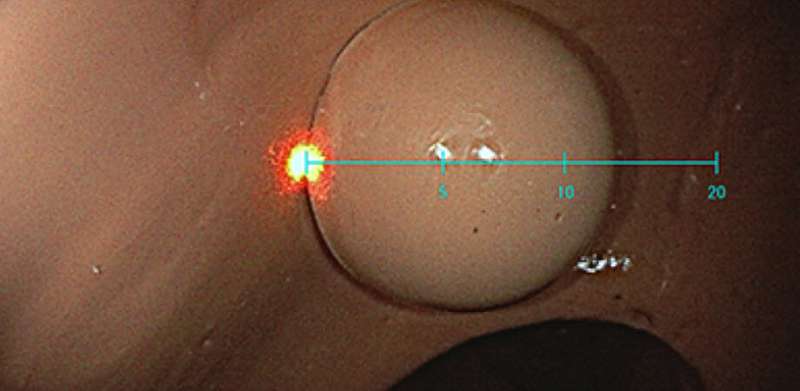A virtual ruler that estimates the size of colorectal polyps


Colorectal polyps—fleshy growths occurring in the lining of the colon or rectum—are an important risk factor for colorectal cancer. Colonoscopy is a nonsurgical procedure that doctors use to look for colorectal polyps using an endoscope, a thin, flexible tube with a camera on the end. Size is an important characteristic of polyps; doctors consider it in combination with other attributes to decide how frequently they should be checked or whether they should be removed. However, estimating the size of a polyp during endoscopy is not easy.
First, endoscopes use a fisheye lens to get a wider field of view inside the tubular structures of the colon and rectum. While this lens is excellent for exploratory purposes, it greatly distorts the peripheral parts of the image as compared with the central part. Second, the size of an object as it appears on a monitor varies depending on the distance between the tip of the endoscope and the object in question. For these reasons, it is challenging to accurately estimate the size of polyps based solely on the two-dimensional images captured by an endoscope.
Fortunately, researchers from Fujifilm Co. and Okayama University have developed a simple, cost-effective solution to this problem. In a paper published in the Journal of Biomedical Optics, the researchers present a method by which, with the simple addition of a laser pointer to the endoscope and minimal image processing, an adaptive virtual scale can be layered on top of the images seen by the endoscopist in real-time. “Although various tools to accurately measure polyps exist, such as biopsy forceps or snares, introducing additional devices only for polyp size estimation is cumbersome and not effective in terms of procedural time and cost,” explains Yuichi Teramura, Research Manager at Fujifilm and corresponding author of the paper. The method introduced by Teramura’s team involves no additional instrumentation, but instead addresses the clinical need using basic principles of physics.
The rationale behind their novel approach lies in the geometrical concept of triangulation. A small red laser pointer directly below the endoscope objective lens is aimed diagonally upwards, so that the position of the red dot in the captured images changes depending on the distance between the endoscope’s tip and the object that the laser hits. After calibration and once the distance to the target object (polyp) is determined, calculating distances within the image itself based on the known distortion of the fisheye lens is easy. An algorithm detects the red dot in the real-time images of the endoscope and draws a virtual scale with markings for 5, 10, and 20 mm, which the endoscopist can use as an adaptive on-screen ruler to measure polyp size.
The researchers first tested their approach using graph paper with ruled lines in 0.5 mm increments at various distances and tilt angles. Then, they recruited three expert endoscopists, who estimated the size of 33 silicon polyp images in a colon model using both the proposed device and a biopsy forceps. The results were very promising: the digital scale was able to estimate polyp size accurately 60% of the time, as compared to 39% using the traditional biopsy forceps. According to Jonathan Sorger, Vice President of Research at Intuitive Surgical, a leader in surgical robotics, the tests of the virtual scale function presented in the paper demonstrate a marked improvement of both over- and underestimation of polyp size. He says, “It is frustrating that I can use a measurement tool on my iPhone when out in the yard building something with my sons, yet surgeons still drop paper rulers into patients to measure relevant anatomy. It will be exciting to see this method applied in the clinic.”
Source: Read Full Article